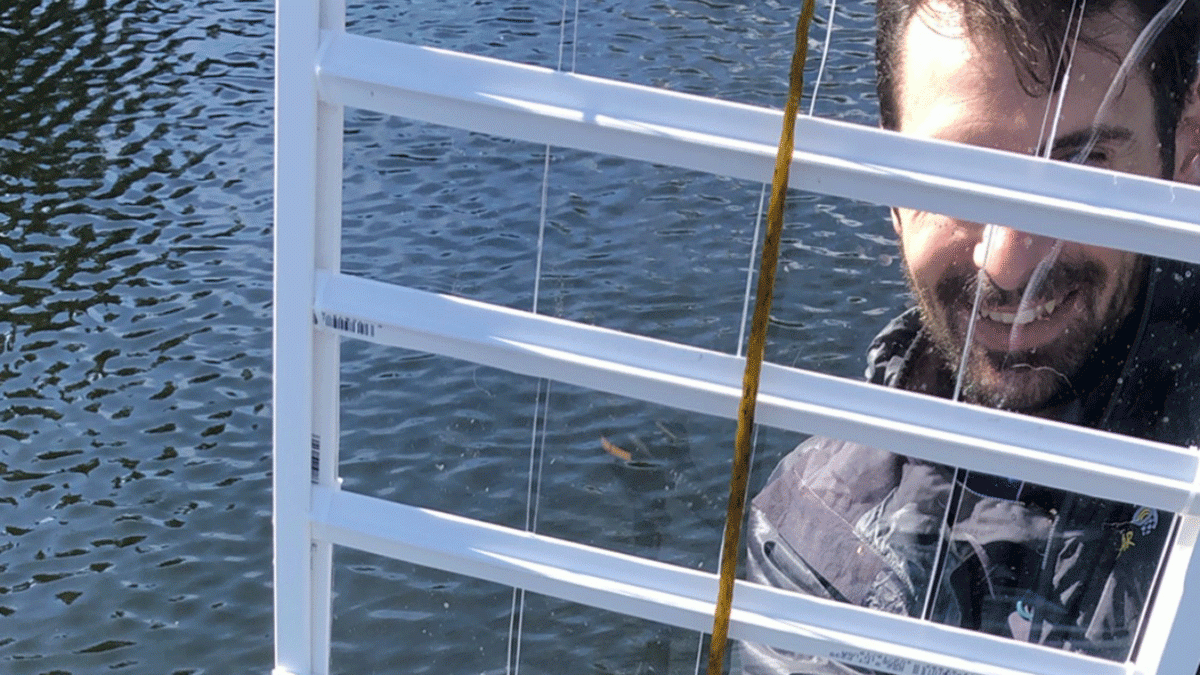
Ken Burkart holds an innovated sampling device that he devised from inexpensive materials from a hardware store.
Anyone who spends time in or near freshwater lakes is probably familiar with the fuzzy green algae that coats most surfaces where light reaches. This common algae is called periphyton and, although seemingly harmless, it recently surprised Dr. James Gawel and Dr. Rebecca Neumann by containing high levels of arsenic in the lakes that they study.
“My undergraduate assistant, Ken Burkart, was looking at levels of arsenic in aquatic plants and got the idea to also measure arsenic in the periphyton that was attached to them,” explained Gawel. “What he found were levels 10-100 times higher than those found in the plants.” Plants and plankton take up arsenic because, chemically, it resembles phosphorus, a limiting nutrient in the lakes that they study.
Because periphyton has so much arsenic in it, the next question is how that arsenic moves up the food chain into the grazers and aquatic insects that feed on it.
Specifically, Gawel and his team are interested in how much arsenic ends up in the snails that feed on periphyton. Some of these snails are an invasive species known as the Chinese Mystery snail, commonly sold in pet stores. They can reach a few inches in size—big enough that people harvest them to eat like escargot. “There are even environmental groups that encourage eating these snails to help reduce the invasive species,” said Gawel.
In order to look at the transfer of arsenic from periphyton to snails, the team needed to collect large amounts of periphyton. This is where Burkart got creative. Previously people had used large plates that were fairly expensive and difficult to employ. Burkart had the idea of using relatively inexpensive window frames to hold 16 plates together, providing a large surface area for sampling. “We went to the local hardware store to see what materials were available and decided on using a combination of different types of exterior composite window moulding, because it was inexpensive and easy to cut and drill.” Each unit costs between $20-$30 to build. “The final design came about as a combination of the intended plans and research aims, what materials were available, and how those materials fit together,” explained Burkart.
Periphyton grows faster as water temperatures warm. Gawel and his team anticipate harvesting sometime in late June or July from the four arsenic-contaminated lakes where the collection devices have been employed. The next step will be to bring the periphyton into the lab for a series of experiments.
First the levels of arsenic will be measured. Then the periphyton will be grown in a high arsenic environment. Because periphyton grow colonially in communities with bacteria, collaborators Dr. Jack Vincent and undergraduate Adam Matulich (both at University of Washington Tacoma) will kill off the bacteria in some of the periphyton before dosing the periphyton with arsenic to determine what role the bacteria play in changing the chemical form of arsenic.
Gawel and Neumann’s team has previously demonstrated that arsenic is more available for the food chain in shallow lakes than in deeper lakes. In deep lakes water tends to stratify into layers of different temperatures and the sediments under the coldest water at the bottom the lake remain fairly inert. In shallow lakes, water warms all the way to the bottom and mixes in a way that brings arsenic from contaminated sediments into the water where it’s more likely to enter the food chain.
Finding high levels of arsenic in periphyton is just one clue in understanding the larger issue of how arsenic moves through the food chain and ultimately may impact human health.

